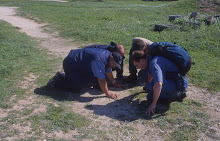domenica 24 luglio 2011
Debito
Riporto quanto scritto da Loretta Napoleoni sull'ultimo "Venerdì" di Repubblica (p. 57): "Il nostro debito pubblico è pari al 120% del PIL (...) 1800 miliardi di euro. (...) Nei prossimi cinque anni l'Italia dovrà rifinanziare la bellezza di 900 miliardi di euro. (...) Che significa tutto ciò? Che se i mercati decideranno di non prestarci più soldi, come è avvenuto per Grecia, Portogallo e Iralanda, non sarà possibile varare un piano di salvataggio: l'Europa unita non ha a disposizione tanto denaro. Morale: se il governo non agisce subito imponeno una tassa patrimoniale una tantum pesantissima (...) rischiamo proprio di finire come i vicini greci.
Etichette:
crise,
debito pubblico,
Grecia,
Italia,
Napoleoni
sabato 23 luglio 2011
Leonard
We are often astounded by the scientific achievements of Leonardo and by the visionary nature of his drawings of plants, anatomy and geology. Although he was also an ingenious engeneer - and his most famous inventions such as the helicopter or the parachute testify this - I think that he begun to draw the things of nature, in particular anatomy, not for scientific interest, but in relationships with painting - the knwoledge of anatomy is essential for the portrait of a human body.
Drawing

Architecture still relies on the Reinessance idea that if you can draw, you can create the world - buildings, paintings, machines, a few century after industrial objects - and thus you are like god. The free masons symbolism of square and compass and the famous painting of the creation where god is represented as an architect is based on this idea. A corollary to the idea is that the architect - not the painter nor the sculptor, that create only images of the world - is like god. The idea is still among us: if you are acquainted with architects you certainly had the feeling that they believe to be able to do everything - to be omni-potent. But science, that rised at the end of the Reinessance - has told us that the structure of the world - and therefore the ability to modify it or even create things - is based on certain mathematical relationships among the parts - in some way Pythagorean conceptions are at the base of our modern vision of the world, and it is no case that Kepler was guided by Pythagorean principles in the discovery of the laws of motion of planets. Drawing as nothing to do with these mathematical relationships, although it can suggest them, and this explains why archtitect believe they can do everything but usually are able to do nothing - often not even buildings.
Etichette:
architettura,
dio,
Keplero,
Pitagora,
Rinascimento,
scienza
venerdì 22 luglio 2011
Meier

I recentrly visited the "Jubilaeum church" of Richard Meier in Tor Tre Teste, in the suburbs of Rome. Simply perfect, and the comparison of this church with the "Ara pacis", that is not a very successful building, imposes a couple of consideration. The first is that the commisioner of a building does matter: the Church has a little more experience than Walter Veltroni in art and architecture. The second is that the leftist government of Rome of the former years wanted to break drastically with the past in inserting a modernist intervention in the fundamentally baroque urban tissue of the centre of Rome - but at the same time asked Meier not to break too drastically with the case that dated to the '30s of the last century and was a modest example of fascist rationalism -so that the german architect was obliged to reconcile his "lecorbuserian" conception with the fascist pompous attitude, he had to mantain more or less the original proportion and the organization of the ceiling, he had to build a wall of travertine - travertine was much loved by fascists because it reminded the Colosseum, but originally travertine was a relatively poor material that was hidden - in the Colosseum and elseqhere, by wonderfully coloured marbles .... In practice, the usualo stop and go strategy of PCI-PDS-PD
Etichette:
Ara Pacis,
architettura,
Chiesa,
Colosseo,
committente,
Meier,
PD,
razionalismo,
Roma,
travertino,
Veltroni
lunedì 11 luglio 2011
Default

Prodi aveva proposto al Paese di fare qualche sacrificio per risanare il mostruoso debito pubblico e restare nell'euro. I lavoratori tutto sommato furono d'accordo (sacrificio più, sacrificio meno), ma al 20% ricco del paese venne quasi una crisi isterica: "mi vogliono togliere qualche euro, sono rovianato! (in stile zio Paperone). Prodi cadde, venne la politica di "tolleranza" dell'evasione e di aumento della tassazione indiretta di Berlusconi e Tremonti. Vent'anni dopo, siamo sull'orlo della bancarotta. Il bel sito http://globaleconomicanalysis.blogspot.com/ chiama l'Italia "l'elefante invisibile".
Incidentalmente, questo 20% più ricco attualmente ha i soldi che gli escono dalle orecchie. Se per una volta toccassimo i forti invece che come al solito i deboli, mi sa che avremmo un bilancio florido; fu del resto l'errore di Prodi, chiedere sacrifici a tutti, invece di chiedere di più a chi ha di più - del resto a un democristiano non si può chiedere di diventare socialista.
Etichette:
Berlusconi,
crise,
debito pubblico,
Prodi,
Tremonti
Iscriviti a:
Post (Atom)
